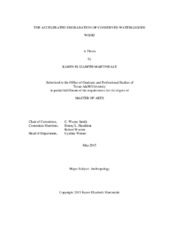| dc.description.abstract | There is a great deal of variation in conservation treatments for waterlogged wood. There is also a great deal of variation in the environments where the artifacts are displayed and stored. Accelerated testing could be used as a tool to determine the best treatment for an artifact in a given environment, to adjust the environment to suit the artifact, or as a comparative tool for new conservation treatments. Accelerated testing methods used by manufacturing industries may be too expensive to be commonly used by conservation laboratories, but it is possible for conservation laboratories to create their own accelerated testing chambers that yield accurate comparisons.
In this study, the author treats samples of archaeological waterlogged wood using PEG, freeze drying, and silicone oil treatments, then subjects the wood samples to four accelerated environments inside glass chambers. An “ideal” museum environment acts as a control, maintaining a temperature of 20–22°C (68–71.6°F), a relative humidity of 16%−20% using silica gel, and a lighting cycle of five days with light and two days without light; a museum with little environmental control is simulated by using a heated seedling mat to increase the temperature of the chamber to 28–30°C (82.4–86°F), increasing the relative humidity by adding 5 ml of water weekly, and has a lighting cycle of five days with light and two without light; outdoor storage building conditions are simulated by keeping the chamber in an oven programmed to maintain a temperature of 35°C (95°F), increasing relative humidity by adding 5 ml of water weekly, and limiting light; cool storage conditions are simulated by keeping the chamber in a refrigerator that maintains a temperature of 4–6°C (39.2–42.8°F), maintaining a relative humidity of 16%−20% using silica gel, and limiting light. At all stages, dimensions and physical changes of each sample were recorded and each sample was photographed. The samples reacted to the accelerated conditions in a predictable way: the samples treated with PEG were the most reactive to increased humidity, the samples treated by freeze drying reacted to a lesser extent, and the samples treated with silicone oil did not visibly react. The resulting conditions of the samples prove that meaningful comparisons can be made between samples, even without the specialized weathering chambers used by industry. | en |


